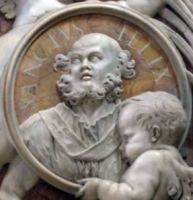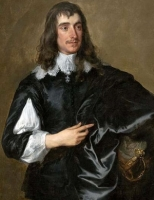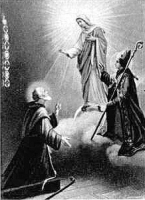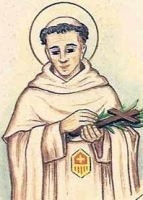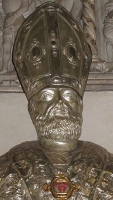Bl. John Alcober
Feastday: December 30
Death: 1748
Canonized: Pope John Paul II
Dominican martyr of China. Born in Gerona, Spain, he entered the Dominicans, being sent in 1728 to China as a missionary. Arrested in 1746 by Chinese officials, he was held in prison until strangled to death. He died with Blessed Peter Sanz and other Dominicans.
Blessed Eugenia Ravasco
Profile
Third of six children born to Francesco Matteo and Carolina Mozzoni Frosconi. Eugenia's mother died when the girl was three, her father moved with some of the children to Genoa, Italy to find work, and Eugenia was raised in Milan by her pious aunt Marietta Anselmi. The family reunited in Genoa in 1852, but Eugenia's father died in March 1855, and she moved in with her pious relatives Luigi and Elisa Ravasco (and their ten children).
Eugenia grew up in a time when opposition to the Church and the clergy was on the rise, and Freemasons actively opposed the Catholic hierarchy. Her family, however, including her extended one, were open about their faith, and active in their parish life; Eugenia made her First Communion and Confirmation on 21 June 1855, and began a habit of frequent prayer.
In December 1862, uncle Luigi died, and Eugenia took over care of the family. The pious home continued in turmoil as her brother, Ambrose, join the anti-clerical forces. Her remaining family wanted Eugenia to marry, but she felt a call to religious life, and during a mission on 31 May 1863, the young woman felt a strong desire to enter a vocation dedicated to the Sacred Heart of Jesus. With the help of her spiritual director she began teaching catechism and helping poor girls, especially those who lived on the street. Other young women joined in her work, and on 6 December 1868, with the help of Canon Magnasco, she founded the Sisters of the Sacred Hearts of Jesus and Mary (Ravasco Institute) to teach catechism and open secular schools for the poor.
Mother Eugenia served the rest of her life as first Supererior to the Congregation and worked with great courage in the face of growing anti-clerical persecution in her region. She travelled Italy, France and Switzerland to start new communities, teach, give direction to new sisters, and correct the anti-Catholic press. The Congregation received diocesan approval in 1882, the first group of sisters made their perpetual profession in 1884, and they received papal approval in 1909. Today the Sisters work in Albania, Italy, Switzerland, Argentina, Bolivia, Chile, Colombia, Mexico, Paraguay, Venezuela, Africa and the Philippines in schools, parishes and missions, dedicated to youth, the poor, and promoting the dignity of women.
Born
4 January 1845 at Milan, Italy
Died
30 December 1900 at Genoa, Italy of natural causes
Beatified
27 April 2003 by Pope John Paul II
Blessed Giovanni Maria Boccardo
Also known as
Father of the Poor
Profile
Eldest of ten children born to Gasparo Boccardo and Giuseppina Malerba; his was a pious family - he was baptized at one day of age, three of his brothers became priests, one of them Blessed Luigi Boccardo. He studied with the Barnabites, graduating from their high school in 1864, and then the diocesan seminary. Ordained on 3 June 1871 in the archdiocese of Turin, Italy. Giovanni was drawn to religious life, but was assigned to work in seminary, first teaching and then becoming the spiritual director of young seminarians in Chieri, Italy in 1873 and then in Turin. Received a doctorate in theology on 1 February 1877. Honorary canon of the church of Santa Maria della Scala in Chieri. Friend of Saint John Bosco, Saint Leonard Murialdo, and Blessed Joseph Allamano. Parish priest in Pancalieri, Italy in 1882 where he spent the rest of his life as a beloved pastor, caring especially for the sick and the poor, filling in at other parishes, ensuring religious education of children, and maintaining a prison ministry. Working with the sick during a cholera epidemic in 1884 impressed on Giovanni the need for better medical care for the poor; he founded a hospice for the impoverished sick on 6 November 1884. Founded the Poor Daughters of Saint Cajetan with a mission to care for the poor sick, the long term sick, sick priests, the elderly and the neglected; their work continues today in Italy, Brazil, Benin and Argentina. In 1911 Father Giovanni was stricken with a form of paralysis that eventually led to his reluctantly giving up all areas of ministry his final two years. His private writings on matters spiritual runs to 44 volumes.
Born
20 November 1848 in Ca'Bianca, Moncalieri, Turin, Italy
Died
• 30 December 1913 in Moncalieri, Turin, Italy of natural causes
• re-interred at the mother house of the Poor Daughters of Saint Cajetan in Pancalieri, Italy in 1924
Beatified
• 24 May 1998 by Pope John Paul II
• the beatification miracle involved the complete healing from cancer of 80-year-old Lina Alvez De Oliveira of Sao Paolo, Brazil on 12 February 1968
Patronage
against cancer
Saint Egwin of Worcester
ஈவ்ஷாம் நகர் புனிதர் எக்வின்
துறவி, ஆயர், நிறுவனர்:
பிறப்பு: ---
இறப்பு: டிசம்பர் 30, 717
ஈவ்ஷாம் துறவு மடம்
ஏற்கும் சமயம்:
ரோமன் கத்தோலிக்க திருச்சபை
முக்கிய திருத்தலம்:
ஈவ்ஷாம் துறவு மடம்
நினைவுத் திருநாள்: டிசம்பர் 30
புனிதர் எக்வின், ஒரு “பெனடிக்டைன் துறவியும்” (Benedictine monk), “இங்கிலாந்து” (England) நாட்டிலுள்ள “வார்செஸ்டர்” (Worcester) மறைமாவட்டத்தின் ஆயருமாவார்.
இங்கிலாந்தின் “வார்செஸ்டர்” (Worcester) மாகாணத்தின் பிரபுக்கள் குடும்பத்தில் பிறந்த எக்வின், “மெர்சியன்” அரச வம்சத்தைச் (Descendant of Mercian kings) சேர்ந்தவர் ஆவார். அவர் “மெர்சியாவின்” அரசன் (King of Mercia) “எத்தெல்ரெட்டின்” (Æthelred) மருமகனாக இருக்கலாம் என்று நம்பப்படுகின்றது.
ஏற்கனவே அவர் ஒரு துறவியாகையால், அரச வம்சத்தினரும், குருமாரும், பொதுமக்களும் இணைந்து, அவர் ஆயராக பொறுப்பேற்கவேண்டுமென வலியுறுத்தினர். அவர், கி.பி. 693ம் ஆண்டுக்குப் பின்னர் ஆயராக அருட்பொழிவு பெற்றார்.
ஒரு ஆயராக கைம்பெண்களுக்கும், அனாதைகளுக்கும், நியாயமான நீதிபதிகளுக்கும் பாதுகாவலராக இருந்தார். கிறிஸ்தவ அறநெறியை ஏற்றுக்கொள்வதன் மூலம், குறிப்பாக கிறிஸ்தவ திருமணம் மற்றும் மதகுருக்களுக்காய் உள்ளூர் மக்களுடன் அவர் போராடினார். இவர் மேற்கொண்ட கடுமையான ஒழுக்க நடவடிக்கைகள், இவர்மீது மக்களிடையே ஒரு வெறுப்பை உருவாக்கியது. அரசன் “எத்தெல்ரெட்” (Æthelred) இவருடைய நண்பரான காரணத்தால், இறுதியில் அவரது திருச்சபை மேலதிகாரிகளுக்கு வழிகாட்டினார். திருத்தந்தையின் நியாய நிருபணம் வேண்டி, ரோம் நகருக்கு திருயாத்திரை மேற்கொண்டார். திருயாத்திரைக்கான பயண தயாரிப்பின்போது, தமது கால்கள் இரண்டிலும் விலங்கிட்டு பூட்டினார். அதன் சாவியை “ஏவன்” (River Avon) நதியில் எறிந்தார்.
எக்வினும் அவரது தோழர்களும் “”ஆல்ப்ஸ்” (Alps) மலையை கடக்கும் வேளையில், அவர்களுக்கு தாகம் எடுக்கத் தொடங்கியது. ஆயரின் பரிசுத்தத்தை ஒப்புக் கொள்ளாத அவரது தோழர்களில் ஒருவர், மோசே பாலைவனத்தில் ஒருமுறை செய்ததுபோல் தண்ணீருக்காக ஜெபிப்பதை அவமானமாக நினைத்தார். ஆனால் அவரை விசுவசித்த மற்றவர்கள், அவிசுவாசிகளைக் கடிந்துகொண்டு, உண்மையான நம்பிக்கை மற்றும் நம்பிக்கையுடன் வேறுவிதமான குரலில் அவரைக் கேட்டார்கள். எக்வின் தரையில் சாஷ்டாங்கமாய் விழுந்து செபித்தார். செபித்து எழுகையில், சுத்தமான பளிங்குபோன்ற நீரோடை பீரிட்டு ஊற்றெடுப்பதைக் கண்டனர்.
ரோம் நகரில், அப்போஸ்தலர்களின் கல்லறையின்மீது செபிக்கும்போது, அவர்களுடைய தோழர்களில் ஒருவர், “ஏவன்” (River Avon) நதியில் இவர் விட்டெறிந்த சாவி, இத்தாலியின் “டிபேர்” (Tiber) நதியில் பிடிக்கப்பட்ட மீனின் வாயில் இருந்ததாக கொண்டுவந்து கொடுத்தார். எக்வின் தமக்குத் தாமே போட்டுக்கொண்ட கால் விலங்குகளை விலக்கிக்கொண்டார். உடனடியாக திருத்தந்தையிடமிருந்து, அவரது எதிரிகளுக்கெதிரான ஒரு அதிகாரப்பூர்வ வெளியீடை பெற்றார்.
இங்கிலாந்து திரும்பிய எக்வின், “ஈவ்ஷாம்” (Evesham Abbey) துறவு மடத்தினை நிறுவினார். இது, மத்தியகால இங்கிலாந்தின் மிகப்பெரிய பெனடிக்டைன் துறவு இல்லமாக மாறியது. இம்மடம், அன்னை கன்னி மரியாளுக்கு அர்ப்பணிக்கப்பட்டது. தாம் நிறுவிய மடாலயத்திலேய அவர் மரித்தார். அவரது உடல் அங்கேயே அடக்கம் செய்யப்பட்டது.
Also known as
• Egwin of Evesham
• Ecgwin, Ecgwine, Eegwine, Egvino, Egwinus
Additional Memorials
• 10 September (translation of his relics)
• 11 January (translation of his relics)
Profile
English nobility, and the descendant of Mercian kings. Consecrated to God in his youth. Benedictine monk. Bishop of Worcester, England from 692 to 711.
There was a need in his diocese for some reform, but Egwin let it get out of hand, and he was charged with being too severe with his priests. To answer the charges, give everyone a chance to cool off, and show his repentance for any harm done, he made a penitial pilgrimage to Rome. Legend says that he locked his feet in shackles and threw the key into the River Avon; when he arrived in Rome the key was miraculously found in the belly of a fish he bought in the market.
Founded the Benedictine monastery of Evesham, England; the site was chosen because of an apparition of the Virgin Mary to a local herdsman. It became one of the great Benedictine houses of the Middle Ages.
Born
7th century England
Died
• 30 December 717 of natural causes
• buried at the monastery at Evesham, England
• relics translated for veneration in 1039
• relics translated again in 1077 when they were taken on tour throughout the region which drew enough donations to rebuild the monastery church
Blessed Margaret Colonna
Also known as
• Margaret of Cortona
• Margarita, Margherita, Marguerite
Profile
Daughter of Prince Odo Colonna of Palestrina, Italy. Her parents died when Margaret was young, and she had to care for her two brothers, the youngest of whom grew to be Cardinal James Colonna in 1278. Having refused a marriage offer by the chief magistrate of Rome, Margaret retired from the world, and turned the family castle near Palestrina into a retreat where she passed her time in piety and penance. Noted for charity to the poor, which was more than once miraculously rewarded. Through the influence of her brother the cardinal, Margaret obtained papal approval for a community of Urbanist Poor Clares at her castle, where she became superioress. Suffered her last seven years from a terribly painful ulcer, which she used as a chance to demonstrate resignation. After her death, her community move to the convent of San Silvestro in Capite in Rome, Italy, from where they were driven to the convent of Santa Cecilia in Trastevere in Rome.
Born
c.1255 at Palestrina, Rome, Italy
Died
• 30 December 1284 at Castel San Pietro, Rome, Italy of natural causes
• relics at the convent of Santa Cecilia in Trastevere, Rome
Beatified
17 September 1847 by Pope Pius IX (cultus confirmed)
Pope Saint Felix I
Profile
Son of Constantius; little else is known of his early life. Chosen 26th pope in 269. Believed to have given sanction to the ancient practice of celebrating anniversary Masses at the graves of martyrs. First to condemn the heresy spread by Paul of Samosata which taught that Christ was a mere man used as a puppet by God. Suffered through the persecutions of Aurelian, working personally to bring non-Christians to the faith. Some old records indicate that he was a martyr, the reason for his inclusion on early calendars of the saints, but they were apparently in error, confusing him with another Felix of the era.
Born
in Rome, Italy
Papal Ascension
269
Died
274
Representation
pope with an anchor
Saint Anysia of Salonika
தூய அனிசியா
இன்று அன்னையாம் திரு அவை தூய அனிசியாவின் நினைவுநாளைக் கொண்டாடுகின்றது. இவர் மூன்றாம் நூற்றாண்டின் இறுதியில் ‘புறவினத்தாரின் திருத்தூதர்’ என அழைக்கப்படுகின்ற பவுலால், கிறிஸ்தவ மறையைத் தழுவிய தெசலோனிக்காவில் பிறந்தவர்.
அனிசியாவின் பெற்றோர், அவருடைய சிறுவயதிலே அவரை விட்டுப் பிரிந்தனர். அதனால் அவர் தனித்துவிடப்பட்டார். ஆனாலும் அவருடைய பெற்றோர் வழியாக அவருக்குக் கிடைத்த சொத்துக்களைக் கொண்டு அவர் ஏழைகளுக்கும் விளிம்புநிலையில் இருந்த மக்களுக்கும் உதவி செய்து வந்தார்.
இந்நிலையில் தெசலோனிக்காவில் ஆளுநனாக இருந்த டெல்சியுஸ் என்பவன் கிறிஸ்தவர்களுக்கு எதிராகக் கொலைவெறித் தாக்குதலை நடத்தத் தொடங்கினான். ஒருநாள் கசன்றா வாயில் அருகே இருந்த ஆலயத்தில் நடைபெற்ற ஞாயிறு வழிபாட்டில் கலந்துகொள்வதற்காக அனிசியா வேகமாகச் சென்றுகொண்டிருந்தார். அப்போது அவரை வழிமறித்த படைவீரன் ஒருவன், “நீ எங்கே போகிறாய்? எதற்காகப் போகிறாய்?” என்று கேள்விமேல் கேள்வி கேட்டான். அதற்கு அனிசியா மிகவும் துணிச்சலாக, “நான் ஆலயத்திற்குச் சென்று கொண்டிருக்கிறேன். அங்கு என் ஆண்டவர் இயேசுவை வழிபடப் போகிறேன்” என்றார்.
இதைக் கேட்டு சினமுற்ற படைவீரன், அவரை சூரியக் கடவுளின் கோவிலுக்கு இழுத்துச் சென்று, அங்கிருந்த கடவுளை வழிபடச் சொன்னான். இதற்கு அவர் சம்மதிக்கவில்லை. மாறாக, “நான் என் ஆண்டவர் இயேசுவைத் தவிர வேறு யாரையும் வழிபட மாட்டேன்” என்றார். இதனால் வெகுண்டெழுந்த படைவீரன் அவரை அந்த இடத்திலேயே தலையை வெட்டிக் கொன்றுபோட்டான். இவ்வாறு அனிசியா 304 ஆம் ஆண்டு ஆண்டவர் இயேசுவுக்காக இரத்தம் சிந்தி உயிர்துறந்தார்.
இவர் கொல்லப்பட்ட ஒருசில ஆண்டுகளிலேயே, அதாவது 313 ஆம் ஆண்டு உரோமையை ஆண்ட கான்ஸ்டான்டைன் என்ற மன்னன், கிறிஸ்தவ மதத்தை அரச மதமாக ஆக்கினான். இதனால் அனிசியா கொல்லப்பட்ட அதே இடத்தில் அவருக்கு ஒரு பெரிய ஆலயம் கட்டி எழுப்பப்பட்டது.
Also known as
Anysia of Thessalonica
Profile
Born to a wealthy and pious family, Anysia lived private vows of chastity and poverty, praying and using her wealth to help the poor. One day a Roman soldier accosted her as she was on her way to services. When he discovered she was a Christian, possibly she crossed herself in fear, he beat her, and said was going to drag her to a pagan temple and force her to make a sacrifice. When he tore off the veil she habitually wore as a sign of her chastity, she spit in his face; he murdered her.
Born
in Salonika, Thessaly, Greece
Died
stabbed with a sword on 30 December 304
Saint Ruggero of Canne
புனித_ரோஜர் (1060- 1129)
டிசம்பர் 30.
இவர் (#StRogerOfCannae) இத்தாலியைச் சார்ந்தவர். சிறுவயது முதலே இறைவன்மீது ஆழமான நம்பிக்கைகொண்டிருந்த இவர் 'கன்னே' (Cannae) என்ற நகரின் ஆயராகத் திருப்பொழிவு செய்யப்பட்டார்.
இவர் மக்களிடத்தில் மிகுந்த இரக்கம் கொண்டிருந்தார். இவர் ஆயராக இருந்த காலத்தில் ஆயர் இல்லம் ஏழைகளுக்காக எப்பொழுதும் திறந்தே இருக்கும்.
மேலும் இவர் ஆன்மாக்களை மீட்க வேண்டும் என்பதற்காக முழுமூச்சாகச் செயல்பட்டார்.
இவர் தனது மறைமாவட்டத்தின் பல பகுதிகளுக்கு நடந்தே சென்றார். இவர் பகல் நேரங்களில் மக்களைச் சந்திக்க நடந்து சென்றபோது, கழுகு ஒன்று இவருக்கு நிழல் தரும் என்று பாரம்பரியமாக ஒரு செய்தி சொல்லப்படுகிறது.
இவர் தனக்கு வயது ஏறிக்கொண்டே போனாலும் இறைப்பணியை மிகுந்த ஈடுபாட்டோடு செய்து வந்தார். இப்படியிருக்கையில் இவர் 1129 ஆம் ஆண்டு மூப்பின் காரணமாக இறையடி சேர்ந்தார்.
Also known as
Roger
Profile
Pious youth. Deacon. Reluctant bishop of Canne, Italy at age 30. Legend says that when he travelled his diocese, an eagle flew above him to shelter him from the weather.
Born
mid-11th century
Died
• 30 December 1129 of natural causes
• buried in the cathedral in Canne, Italy
• relics transferred to Barletta, Italy in 1276
Patronage
• Barletta, Italy
• Trani-Barletta-Bisceglie, Italy, archdiocese of
Representation
• crosier
• eagle
Saint Geremarus
Also known as
Germer, Geremar, Geremaro
Profile
Born to the Frankish nobility, he was educated in Beauvais, France. Worked with Saint Eloi. Part of the court of King Dagobert I. Married. Father. Advisor to King Clovis II. With his wife's consent, he retired to the abbey of Pentale on the Seine in France. Abbot at Pentale, but he was so severe with his monks that a group tried to kill him. He resigned, then retired to become a hermit in a cave near the abbey. Founded Flay Abbey between Beauvais and Rouen in France in 655; it was later renamed Saint-Germer in his honour.
Born
7th century at Beauvais, France
Died
c.658 at Flay Abbey, France of natural causes
Saint Perpetuus of Tours
Also known as
Perpet, Perpetue, Perpetuo
Profile
Related to Saint Eustachius of Tours and Saint Volusianus of Tours. Bishop of Tours, France for 30 years. Restored ecclesiastical discipline in his suffragan dioceses to the point that unworthy priests were removed from service. Built churches and monasteries.
Died
c.490
Saint Anysius of Thessalonica
Also known as
Anysius of Salonika
Profile
Bishop of Thessalonica, Macedonia in 383, he was involved in the political and religious struggles of the time. Vicar apostolic of Illyricum. Defended Saint John Chrysostom during that saint's exile. Highly regarded by his peers, Saint John Chrysostom, Saint Ambrose of Milan, Pope Saint Innocent I, and Pope Saint Leo the Great.
Died
c.410
Blessed Richard of Wedinghausen
Also known as
• Richard of Arnsberg
• Richard of Anglicus
Profile
Member of the Premonstratensians. Canon of the Norbertine monastery of Wedinghausen in Arnsberg, Germany. Theological writer.
Born
early 12 century in Germany
Died
c.1190 at the Norbertine monastery of Wedinghausen in Arnsberg, Germany of natural causes
Blessed Raoul of Vaucelles
Also known as
Radulphe, Ralph, Raul, Rodulphe
Profile
Benedictine Cistercian monk and spiritual student of Saint Bernard at Clairvaux Abbey. Sent by Bernard to found and govern a Cistercian abbey of Vaucelles, diocese of Cambrai, France.
Born
in England
Died
1152 of natural causes
Saint Raynerius of Aquila
Also known as
Rainer, Raniero, Rainerius
Profile
Bishop of Forconium (modern Aquila), Abruzzi region, Italy. Noted for his excellent administrative skills, but no details about the man have survived.
Died
1077 of natural causes
Canonized
by Pope Honorius III
Saint Hermes of Moesia
Also known as
Ermete, Hermas
Profile
Exorcist. Martyr.
Died
c.300 in Moesia (in modern Bulgaria)
Representation
• man on horseback exorcising a devil from a woman holding a rope
• man on horseback exorcising a devil from a woman holding a child
Saint Sebastian of Esztergom
Profile
Monk. Archbishop of Esztergom, Hungary in 1002. Worked with Saint Stephen to evangelize the Hungarian people.
Died
c.1036
Saint Eugene of Milan
Also known as
Eugenius
Profile
Bishop of Milan, Italy.
Saint Liberius of Ravenna
Profile
One of the first bishops of the diocese of Ravenna, Italy.
Died
c.200 of natural causes
Martyrs of Alexandria
Profile
A group of Christians martyred in the unrest caused by Monophysite heretics. We know the names for five of them - Appian, Donatus, Honorius, Mansuetus and Severus.
Died
c.483 at Alexandria, Egypt
Martyrs of Oia
Profile
A group of Christians martyred together, date unknown. The only details to have survived are the names - Cletus, Florentius, Papinianus, Paul, Serenusa and Stephen.
Died
Oia, Greece
Martyrs of Spoleto
ஸ்போலேட்டோ நகர புனிதர் சபினஸ்
ஆயர்/ மறைசாட்சி:
ஏற்கும் சமயம்:
ரோமன் கத்தோலிக்க திருச்சபை
பிறப்பு: கி.பி. மூன்றாம் நூற்றாண்டு
இத்தாலி
இறப்பு: கி.பி. 303
ஸ்போலேடியம், ரோமன் ஊம்ப்ரியா (தற்போதைய ஸ்போலேட்டோ, ஊம்ப்ரியா, இத்தாலி)
(Spoletium, Roman Umbria (Modern-day Spoleto, Umbria, Italy)
நினைவுத் திருநாள்: டிசம்பர் 30
பாதுகாவல்: சியென்னா, அசிசி, ஃபெர்மோ (Fermo)
ஸ்போலேட்டோ நகர புனிதர் சபினஸ், "டயோக்லேஷியன்" (Diocletian) என்ற அரசனின் அடக்குமுறைகளை எதிர்த்து உயிர்த்தியாகம் செய்த கிறிஸ்தவ ஆயர் ஆவார்.
சரித்திரவியலாளர்களின்படி, "எட்ரூரியா" (Etruria) மற்றும் ஊம்ப்ரியா" (Umbria) நகரங்களின் ஆளுநரான (Governor) "வெனஸ்ஷியன்" (Venustian) என்பவன் சபினஸ் மற்றும் அவரது திருத்தொண்டர்களை “அசிசி” (Assisi) நகரில் கைது செய்வித்தான். அரசன் "டயோக்லேஷியனின்" (Diocletian) ஆணைப்படி, கிறிஸ்தவர்கள் அனைவரும் பிற கடவுளர்களை ஏற்றுக்கொள்ள வேண்டும் அல்லது அவர்களின் உடமைகளை பறிமுதல் செய்துவிட்டு அவர்கள் கொல்லப்படவேண்டும் என்பதாகும்.
மிகச்சிறந்த முறையில் கிறிஸ்துவை பின்பற்றிய சபினசின் விசுவாசத்தை பரிகசித்த ஆளுநர் "வெனஸ்ஷியன்" (Venustian), இறந்து போன மனிதனை (கிறிஸ்து இயேசுவை) ஆராதிக்குமாறு சபினஸ் மக்களை தூண்டுவதாக குற்றம் சாட்டினான். மரித்த இயேசு மூன்றாம் நாள் மரித்தவரிலிருந்து உயிர்த்தெழுந்ததாக கூறியதைக் கேட்ட "வெனஸ்ஷியன்", சபினசையும் அவ்வாறு செய்ய அழைத்தான்.
"வெனஸ்ஷியன்" சபினசின் கைகளை வெட்டி எறிந்தான். அவரது திருத்தொண்டர்கள் பயத்தால் அஞ்சி நடுங்கினர். ஆனால் சபினஸ் அவர்களை அஞ்சாதிருக்க கூறினார். கிறிஸ்தவ விசுவாசத்தில் உறுதியாயிருக்க உற்சாகப்படுத்தினார். ஆனால் திருத்தொண்டர்கள் அனைவரும் இரும்புக் கொக்கிகளால் உடல் முழுதும் கிழிக்கப்பட்டு மரித்தனர்.
அதன்பின்னர் சிறையில் அடைக்கப்பட்ட சபினஸ் மீது இரக்கம் கொண்ட “செரீனா” (Serena) என்ற பெண்ணொருவர் இவர்மீது பரிதாபம் கொண்டு இவருக்கு பணிவிடை செய்தார். சிறையில், பிறப்பிலேயே பார்வையில்லாத ஒரு கைதியின் பார்வையை சபினஸ் மீட்டு கொடுத்தார். இயற்கையாகவே சிறிது கண்பார்வை குறைவாயிருந்த "வெனஸ்ஷியன்", இதனைக் கேள்வியுற்றதும், சபினசிடம் சென்று, தம்மையும் குணப்படுத்துமாறு கூறினான். தமது வல்லமையுள்ள செபத்தினால் ஆளுநரின் பார்வையை திரும்ப பெற்றுத் தந்த சபினஸ், "வெனஸ்ஷியனை" மனம் மாற வைத்தார். "வெனஸ்ஷியன்" கிறிஸ்துவை விசுவாசித்தான். பின்னர், அவனே சபினசுக்கு பாதுகாப்பளித்தான்.
இதனைக் கேள்வியுற்ற அரசன் "மேக்ஸிமியானஸ் ஹெர்குலியஸ்" (Maximianus Herculius), "லூசியஸ்" (Lucius) என்ற அரசு அதிகாரியிடம் இதனை விசாரிக்க சொன்னான். "வெனஸ்ஷியன்", அவரது மனைவி மற்றும் இரண்டு மகன்கள் ஆகிய நால்வரும் 'அசிசி' (Assisi) நகரில் வைத்து லூசியஸால் தலை துண்டிக்கப்பட்டு கொல்லப்பட்டனர். அதன் பின்னர், "ஸ்போலேட்டோ" (Spoleto) நகரில் வைத்து சபினஸ் அடித்தே கொல்லப்பட்டார்.
Profile
A group of Christians martyred in the persecutions of Diocletian - Exuperantius, Marcellus, Sabinus and Venustian.
Martyr with St. Exuperantius, Marcellus, Venustian, and companions. They were put to death at Spoleto, Italy, during the persecutions of the Church under Emperor Diocletian. Sabinus was a bishop (he is claimed by several cities, including Assisi, Spoleto, and Faenza); Exuperantius and Marcellus were his deacons; and Venustian and others were converts. The martyrs were brought before the local governor, and Sabinus converted many and cured a blind child.
Died
303 in Spoleto, Italy
Also celebrated but no entry yet
• Elias of Conques





